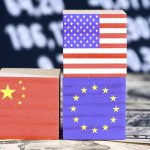This article was originally published in the Internationale Politik Quarterly Summer 2025 Issue: A World Order Minus One
The EU’s cautious reaction to Donald Trump’s trade wars has served it relatively well. Now, however, is the time to switch to a tougher approach, backed up by an internal agreement on sharing the possible costs.
In response to US President Donald Trump’s sweeping tariff agenda, the European Union so far has opted to play for time. It shelved its politically agreed retaliation package on steel and aluminum and held off on countermeasures to the 10 percent baseline tariff or the 25 percent tariffs affecting automobiles and car parts. This restraint, while costing the European Commission some credibility in Washington, was strategically sound: It allowed the EU to monitor how other economies responded and opened space for internal coordination on how to manage divergent appetites for retaliation, as seen in the post-“Liberation Day” deliberations among trade ministers.
But as the July 9 negotiation deadline approaches, with the US administration threatening to expand its tariffs to 50 percent on all EU exports, the limits of this delay-and-see strategy are becoming clear. Trump, having failed to secure a major win in talks with China and facing the viral spread of the “TACO” (“Trump Always Chickens Out”) narrative, may now feel political pressure to act decisively.
It is now time for the EU to move beyond tactical restraint and adopt a strategy of flexible, credible retaliation, underpinned by internal burden-sharing: to preserve its leverage, prevent further escalation, and defend the integrity of the rules-based trading system. At the same time, it should be ready to offer carefully selected concessions that serve its own interests while giving Trump the opportunity to claim a face-saving win at home.
No Deal Will Be the Final Word
With his aggressive tariff policy, Trump has targeted the rules-based trade order itself. Violating World Trade Organization (WTO) commitments, overriding free trade agreements, and reneging on past promises, Trump’s moves have shattered any illusion that deals with the US under his presidency are binding. For the EU, this has two immediate implications.
First, the idea that more accommodating EU positions – or the conclusion of a free trade agreement in the 2010s – would have spared Europe from this disruption is naïve. Calls for a fresh US-EU trade deal have resurfaced, even making their way into the new German coalition agreement. But Trump’s track record exposes the flaw in that logic. He renegotiated NAFTA, the former trade agreement with Canada and Mexico, into the current USMCA, only to violate it 12 days into his second term. With legal commitments treated as optional, the EU cannot assume durability from formal agreements alone.
Second, the credibility of future agreements is also in question. The United Kingdom learned this the hard way. Just days after reaching an agreement in principle, Trump reimposed tariffs on British steel and aluminum, despite the agreed exemption. A 25 percent tariff on British metals, while lower than the 50 percent rate facing other countries, still violates the agreement’s sentiment. The message is clear: Trump’s deals are temporary and subject to unilateral reversal if they are not backed by strong, enforceable incentives. Any deal with the US is unlikely to be the final word. Engagement with Trump is better understood as an ongoing process.
The Need for Flexible Retaliation
The EU must now mount a credible and powerful retaliation package that remains in place even as negotiations proceed and allows for swift, proportionate countermeasures in the case of future transgressions.
China’s response to US tariffs underscores the importance of credible retaliation. By imposing high counter-tariffs and restricting exports of key raw materials, Beijing succeeded in forcing the US back to the negotiating table and achieved a partial tariff truce. Yet even this assertive strategy failed to remove tariffs, emphasizing that retaliation is necessary to maintain leverage, but not sufficient to provide resolution.
For the EU, replicating China’s playbook is neither feasible nor desirable. Europe lacks comparable strategic leverage over the US, particularly in critical raw materials. More fundamentally, the bloc operates within a consensus-driven system that is procedurally slower and politically more complex than China’s top-down model. Unlike Beijing, Brussels also needs to weigh its reliance on Washington’s continued political and military support for Ukraine.
Still, the EU has every reason to move beyond symbolic restraint and towards more decisive action. As the world’s largest trading bloc and a principal defender of multilateral trade rules, the EU also carries a normative responsibility: Failing to respond forcefully to blatant trade transgressions risks normalizing them, thus undermining the credibility of the rules-based order itself.
The EU should kickstart its response by activating the already-agreed retaliation package on steel and aluminum if the US maintains its tariffs. Beyond this, the European Commission has reportedly prepared measures targeting close to €100 billion in US exports including aircraft, machinery, chemicals, and agri-food products, which should enter into force if negotiations fail. Leaving unjustified tariffs of this scale unanswered cannot be in the EU’s strategic interest.
These measures should serve as the core of a flexible, modular retaliation package, complemented by additional measures in services, procurement, and investment, drawing on policy tools such as the Anti-Coercion Instrument. Retaliation must be proportionate, targeted, and reversible—robust enough to deter further escalation, yet adaptable enough to keep the door open for negotiation.
Targeted Incentives
Trump has repeatedly said that he is open to a negotiated agreement. Having established a firm and credible retaliation strategy, the EU should remain willing to offer carefully selected concessions that align with its own interests while allowing Trump to claim a domestic political win. With pressure mounting at home to demonstrate strength in trade negotiations, especially after his failure to extract major concessions from China, Trump may be inclined to accept limited but headline-grabbing deals that he can sell as victories.
The EU should therefore draw up a menu of targeted, reversible incentives that reinforce its strategic priorities. One credible starting point is energy cooperation. As of May 2025, the EU was still sourcing 14.3 percent of its liquefied natural gas (LNG) imports from Russia. The US, already the bloc’s largest LNG supplier, is well-positioned to expand deliveries. Additional purchases could help phase out remaining Russian volumes without increasing the EU’s reliance on fossil fuels.
Second, cooperation on China offers a shared interest. The EU’s growing efforts to address Chinese industrial overcapacity through trade defense instruments and tighter scrutiny of subsidies can be framed as complementing US concerns.
Third, the EU should offer time-limited, reversible regulatory incentives in areas where Trump is politically invested. For instance, it could propose provisional cooperation on emerging technologies (such as autonomous vehicles) through temporary mutual recognition of testing procedures or early-stage regulatory dialogue. Such steps, short of full harmonization, could be tied to the rollback of proposed tariffs on cars and car parts.
Finally, the EU has already offered a zero-for-zero tariff deal on industrial goods. While the original offer gained little traction, Brussels should continue to uphold it. Not because a breakthrough is likely, but to reinforce its credibility as an advocate of rules-based open trade and to put political pressure on Trump by appealing to his own rhetoric of reciprocity. Maintaining the offer exposes any US unwillingness to reciprocate, while adhering to the WTO rulebook that prevents the EU from lowering tariffs for individual trade partners outside a broader agreement. Any complementary regulatory incentives must likewise remain non-discriminatory and consistent with EU internal market law.
The Buffer: EU Burden-sharing
A credible retaliation strategy must consider the uneven economic and political impact a trade conflict with the US has across the EU. Member states are exposed to US tariffs to vastly different degrees: US-bound exports account for 12.5 percent of Ireland’s GDP, but just 0.16% for Cyprus. Exposure is also highly concentrated in specific sectors, such as wine, food, and consumer goods, which are geographically clustered and politically sensitive. Also, the ability to absorb these shocks varies widely. Member states with limited fiscal headroom and unable to cushion domestic fallout may show greater aversion to the necessarily strong European response and give Trump openings to play capitals off against one another.
Spain’s proposal for an EU-level compensation mechanism funded by counter-tariff revenues points in the right direction. But structurally, it faces serious limits: Additional customs revenues simply reduce national contributions to the EU budget and do not generate additional fiscal space.
Instead, the European Commission will need to get more creative to distribute the burden, combining multiple instruments. This should include deploying the budget’s few remaining reserves, including the Common Agricultural Policy’s crisis reserve, Flexibility Instrument, and Globalisation Adjustment Fund. Brussels should further temporarily ease state aid and regulatory constraints to support the most exposed sectors and consider the uneven impact on member states and industries when designing further countermeasures.
The stakes are not only economic: Credible retaliation depends on the EU’s ability to show internal unity. A well-calibrated solidarity package would not eliminate the costs of escalation, but it can prevent discord from weakening the EU’s negotiating position.
From Restraint to Resolve
The EU’s cautious approach, which has served it relatively well in the first months of the second Trump administration, is highly unlikely to be successful in the next phase. Even if the EU were to secure a compromise with the US, any such deal will be temporary and at constant risk of unilateral reversal by the US.
To address this, the EU should set strong incentives for compliance, including credible threats of retaliation, ready to be flexibly deployed in response to any new US measures. To maintain the necessary political unity to sustain this approach over the coming months and years, the EU should invest in internal burden-sharing. A dose of practical solidarity among member states could go a long way.
About the authors
Etienne Höra is Project Manager at the Europe’s Future program at Bertelsmann Stiftung.
Arthur Leichthammer is Policy Fellow for Geoeconomics at the Jacques Delors Centre.










Write a comment